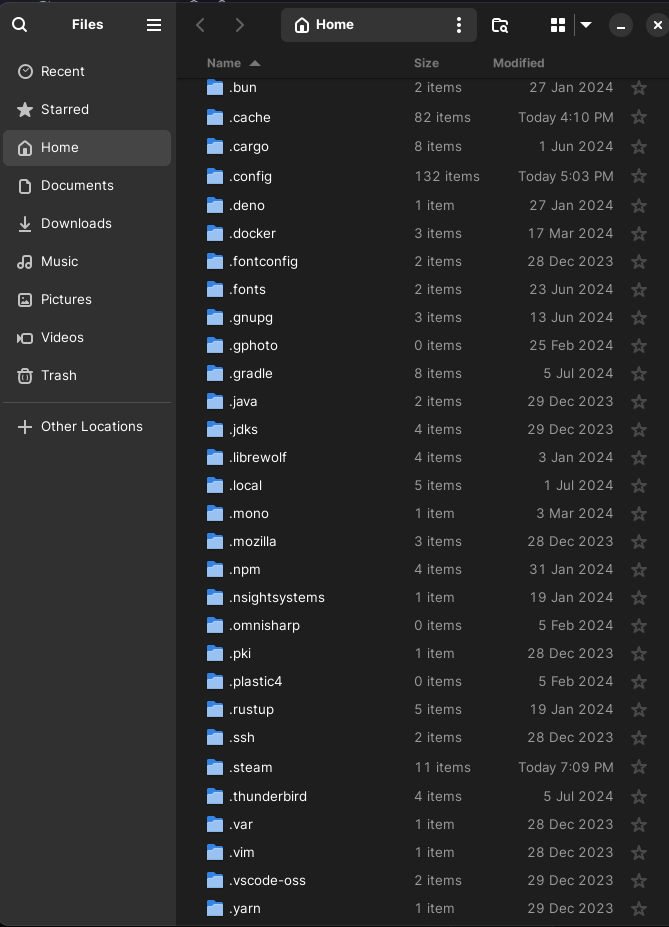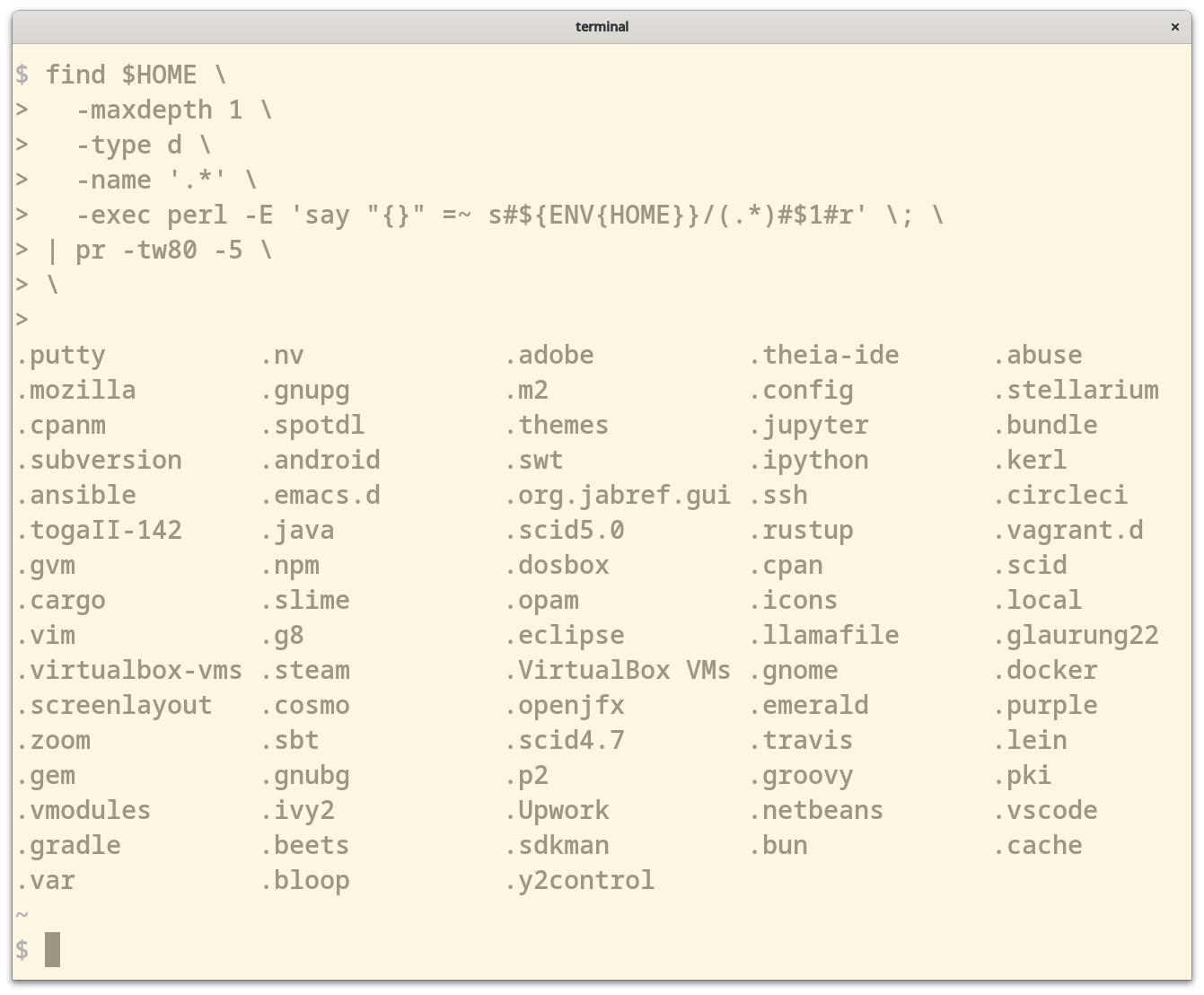Shameless plug: I am the author.
deleted by creator
ls Volatiledeleted by creator
tmpfs (…) to build programs (…) to not be hammering my ssd with unnecessary writes
Sounds useful. How did you setup the directory?
Running
dftells me “tmpfs” is mounted on /run. If I build in that that directory then would it be stored in RAM, or do I need to do something else?deleted by creator
I think I should be able to get this working following your zprofile file. Thanks!
I regret checking this

Whoa I’m a stickler for getting as much as I can out but even I have .zshenv and some other too hard to figure out things in there. How’d you manage a total wipeout?
deleted by creator
That’s awesome!
This is probably a dumb question, but what program is that?
deleted by creator
Lol, the minimalist window decoration had me thinking you were running a terminal inside of the home directory of your file manager. :D
I’ve seen weirder things.
Honestly, that’s what I thought too, and wanted to check that out
Looks like thunar (default file manager on xfce)
But what’s the difference? It’ll be in /home anyways and I heard BSD had some issues with something that could be XDG.
To give one example, what if someone wants to have more than one set of options for the same app? That’s something I’ve needed before, and it’s really hard to accomplish if the app always looks in one specific place for its options.
Oh so it makes it impossible to change config path? Yea that’s a bit inconvenient but you always can just make many files and replace the file in the right directory with the one you want.
Not if you want to use both at the same time. Due example, I’ve wanted to have a local Gnome session that I leave signed in, and another session with different settings that I remote into.
For me personally I just hate that I do not know where to find configs, especially when using a dotfiles repo, it becomes harder than if they’re all available under a common path.
Better organization and backup / restore. For example if you want to restore config files but don’t want to move over the large “.local” folder, applications that write to $HOME will create diifculty.
Because, like /etc, you know there is a designated place for config files. It’s already set for you right there, and there is a standard for it.
/etc can’t be edited on immutable distros and usually apps store the editable config in /home/config and make the /etc one kind of read-only.
In this case it would be
XDG_CONFIG_HOME=/home/config. That simple./etc can’t be edited on immutable distros
False on at least Fedora Atomic[1], NixOS[2] and openSUSE Aeon[3]…
Which ‘immutable’ distros are you referring to?
- On Fedora Atomic, changing
/etcis literally identical to how it goes any other distro; or at least 1-to-1 as on traditional Fedora. The bonus is that a pristine copy of the original/etcis kept inside a sub-directory of/usr. Furthermore, all changes compared to the pristine copy are kept track of. - On NixOS, changes have to be applied through
configuration.nix. Though, regardless, it’s effectively possible to edit and populate/etclike it is on other distros. - It’s explicitly mentioned that
/etcdoes not belong to the immutable base.
Fedora Atomic allowed it recently afaik. I’m always forgetting this. And NixOS is not immutable because of R/W FS.
No sorry, Fedora Atomic has allowed changes to
/etcsince at least 2019. Regarding NixOS, the consensus is that it’s an immutable distro. The immutability of/nix/store/suffices for this.Your notion on Fedora Atomic was false. So, what other ‘immutable’ distro did you have in mind when making that comment?
Please stop harassing me. And idk. I saw that issue but at this point I think it was just misinformation.
Thank you for your honesty! I only intend for the truth to prevail and/or to reach mutual understanding. So please don’t feel attacked. If somehow I came off as such, my apologies; that has never been my intent.
- On Fedora Atomic, changing
/etc is a standard, defined in the filesystem hierarchy standard. This is not:
freedesktop.org produces specifications for interoperability, but we are not an official standards body. There is no requirement for projects to implement all of these specifications, nor certification.
Below are some of the specifications we have produced, many under the banner of ‘XDG’, which stands for the Cross-Desktop Group.
Its nit-picking, but this is a specification, i.e a preference, not an official standard. It would be great if everyone would agree on just one of these to use, but that isn’t a foregone conclusion. Even the actual standard, the FHS, isn’t followed by popular OS’s like NixOS.
Specification, WHATEVER 🙄
The point is it exists for a reason, and clear purpose.
All specifications exist for a reason, and they all have a clear purpose.
What happens when you have 15 that are different and all overlap? When any of 15 is “right?”
I’ve only ever heard of FHS or XDG. Due to the free nature of linux distros, there is no central authority on how they are to be set up, and so there is no difference between those two options in terms of authority. Standards (which XDG is, colloquially) are followed based on popularity.
Yeah, I fully get that. The post and comments were very specific about how if you dont follow XDG, you’re fucking up, while only generally saying that “everything would be better if everyone followed the same standard.”
I pointed out that there are several standards and asked for a unique reason why XDG was the best to use.
I still haven’t heard one, which is fine, but it undermines the “If youre not using, XDG youre a idiot” tone of the post and comments.
I think the logic is that it’s the most used, so to avoid seriously competing standards, it’s better to stick with it.
But what’s the difference?
I can only imagine someone asking this if they a) don’t use the terminal except if Stackexchange says they should and b) have yet to try and cleanup a system that’s acquired cruft over a few years. If you don’t care about it, then let me flip that around and ask why you care if people use XDG? The people who care about it are the people in the spaces that concern it.
Off the top of my head this matters because:
- it’s less clutter, especially if you’re browsing your system from terminal
- it’s a single, specified place for user specific configs, session cache, application assets, etc. Why wouldn’t such important foundational things required for running apps not be in a well defined specification? Why just dump it gracelessly in the user’s root folder outside of pure sloppy laziness?
- it makes uninstalling apps easier
- it makes maintenance easier
- it makes installing on new machines easier
It’ll be in /home anyways and I heard BSD had some issues with something that could be XDG.
🙄
Weird to me that you apparently think the only way of viewing files is in a terminal
It’s weird to me that you think I think that. I do primarily browse files by terminal, but not always. Before I got into heavy terminal use I was a power user of Nemo. In any case, dumping everything in /home does not make for a better gui file browsing experience, either
The implication seemed to be “if you don’t care exactly where all your files are you must not use terminal”. Which I still don’t get. Just about anyone who would even be in a community like this uses terminal a lot anyway.
Someone asking a question doesnt merit the insult of saying they “would never ask if they used a terminal.” I have no particular dog in this fight, but not being a dick isn’t that hard.
It may actually be the best now, but so were the 14 others that came before it. Your stated reasons are the same reasons as everyone agreeing to use any other standard. Consistency, predictability, automation,ease of backup/restore, etc.
What sets this standard apart from all the rest? Based on their own description, they aren’t even an official standard, just one in “very active” use.
So why this, specifically? Just because its what you’re already doing?
Someone asking a question doesnt merit the insult of saying they “would never ask if they used a terminal.” I have no particular dog in this fight, but not being a dick isn’t that hard.
This is true, and something that I’m working on. For some reason my brain is uncharitable in these situations and I interpret it not as a simple question but a sarcastically hostile put down in the form of a question. In this case, “Why would you be dumb and not just put things in /home”. That really is a silly interpretation of the OP question, so I apologize.
As to using this standard, just because this is your preferred standard, doesnt mean its the only standard.
Sure, but the OP was essentially asking “Why isn’t dumping everything into a user’s /home the standard? Why are you advocating for something different?”
Based on their own description, they aren’t even an official standard, just one in “very active” use.
There are a LOT of “unofficial standards” that are very impactful. System D can be considered among those. The page you link to does talk about a lot of specifications, but it also says that a lot of them are already under the XDG specification or the reason for XDG is to bring such a scheme under a single specification, i.e. XDG.
So why this, specifically? Just because its what you’re already doing?
- yes I do use it, so I am definitely biased in that regard
- it bring a bunch of disparate mostly abandoned specification into a single, active one
- it’s the active specification that has learned from past attempts
vim now has an option to put the .vim folder in ~/.config; though I’m not sure if the default plugin/package & syntax folders can be set under ~/.local/share.
You can also just use neovim instead, among other improvements, it’s configs are in the xdg dirs
YOU’RE NOT MY MOM I’LL DO WHAT I WANT
My fellow FOSS users, patches are welcome.
Where did i read this… basically, the .file being hidden being a bug in the early unix filesystem, which got misused to hide configuration files.
Offenders despite XDG-variables set and with no workaround:
- .android: hardcoded in adb and i guess something in mtp too
- .pki: some tool/library Firefox and Chromium sometimes use.
- .steam: yes, that
حق
Are there abstractions available around the XDG specifications to resolve the proper paths?
What language? Python has PyXDG.
In shell it’s simply
XDG_DATA_HOME="${XDG_DATA_HOME:-"$HOME"/.local/share}" XDG_CONFIG_HOME="${XDG_CONFIG_HOME:-"$HOME"/.config}" etc.Thanks, I did not know about PyXDG. That was the type of thing I was asking about.
Use the environment variables.
I do. But you might have misunderstood my question. I was not asking for assistance. I was just curious if there are libraries available which allow easy adoption of the XDG specification. I imagine that such abstractions would be useful for multi-platform software and generally to lower the bar for adoption.
Depends on the programming language. In C# for example, there’s an API to get special folder paths that works in all supported environments (Windows, Linux, MacOS, Android, and I think iOS too). On Linux, it includes fallbacks in case the environment variables aren’t set.
Shout out to xdg-ninja - it’ll find files that are in your home and suggest how to configure the app to use XDG instead. https://github.com/b3nj5m1n/xdg-ninja
Strange that some apps allow configuring it rather than just doing it automatically…
That’s the usual open source way. The config probably came later so they just added the option without changing the default because that would break backward compatibility.
And there would be too much boring work to build a migration.
Thanks, I hadn’t heard of that. Time to add a few hundred lines to my dotfiles :)
After running it and properly configure the paths I once again came to the conclusion: I fucking hate Google.
deleted by creator
Golang puts shit specifically in
$HOME/go. Not even.go. Just plaingo.Why is it so difficult to follow industry standards
That’s what happens when you don’t set $GOPATH I think
That doesn’t make it better.
It makes it insofar better to me that you have the option to change it. You can’t change Mozilla programs to use anything but .mozilla (apart from modifying the source code of course) so for me seeing the folder is at least a way of telling me that the variable is unset.
The better question is which folder is suited the best to store the stuff that goes into $GOPATH
Just because something is worse, doesn’t make the other thing good. A sane and standard default, as others have mentioned, is a small bar to meet.
Of course, but that’s not the point. There should be a sane default, and there isn’t one
Google
following industry standards
pick one
This post literally links to the leading one.
off the shelf go was too annoying for me
Nowadays I set GOENV_ROOT to an XDG location and use goenv instead.
Go pisses me off with that. I separate projects the way I want but go wants every project written in go in one big directory?
I really didn’t like this either. It’s quite surprising, because the rest of Go tooling is quite nice. Not having a venv, or at least something like pnpm-style node_modules is weird
Why would go have a virtual environment or dep tree like node_modules equivalent, it’s not interpreted or dynamically linked.
With modules, dependencies can be vendored.
Obviously it’s not, but you have to download all this shit somewhere before compilation. That’s the whole point
deleted by creator
What I want in
$HOMEare the following directories:If I’m on a GUI-based environment:
- Desktop
- Documents
- Downloads
In general:
- .local
- my_junk_folder_i_made
I’d like everything else to live within something like ~/.local thanks
Maybe Linux should have
.localand.roamingfolders like Windows. local = only useful on this system, roaming = good to sync across systems. Config would be in.roamingif it’s not machine-specific.Does
~/.configfit the bill for the second one?There’s some stuff in
~/.configthat’s specific to the computer. KDE is a good example - a lot of KDE apps mix config and state in the same file. There’s some solutions for syncing these files, like https://github.com/VorpalBlade/chezmoi_modify_manager which is an addon to Chezmoi that can exclude particular keys when storing an INI-style config file in Git.I’m sure there’s some config files in there that are entirely specific to the computer. Things like the Wayland per-monitor scaling settings are in there somewhere I think.
There’s also things like data files that you may want to keep in sync across machines. They’re not really configs.
The only practical difference between Local and Roaming and LocalLow is that developers randomly pick one and dump your game saves in there.
There is a
.localfolder these days.Profile roaming hasn’t been solved aside from NFS mounts. I guess Syncthing might work.
I know
.localexists - My comment was more about.roamingwhich would be nice to exist, but doesn’t currently exist.Profile roaming hasn’t been solved aside from NFS mounts. I guess Syncthing might work.
I’m using Chezmoi to sync some dotfiles, scripts, etc. to a Git repo and that seems to work well enough for me. I’m not syncing much yet, though.
BRB, putting in a PR to make /etc mode 1777 by default.
there’s no place like 127.0.0.1
there’s no place like XDG_CONFIG_HOME.
100% agree and I also despise devs who do this on windows, instead of using %appdata% they’re using c:\users\username\.myappisimportantandtotallydeservesthisdir
I have to use a separate Documents folder for my actual documents lol
I think that also causes issues for roaming profiles and folder redirection. If roaming is turned on then everything in the %appdata%\roaming folder is synced to a server. %AppData%\Local is not. So if your app is using %AppData%\Roaming for temporary data then you are causing a whole bunch on unnecessary IO. Same for using Documents since that if often synced.
Not to mention - this isn’t necessarily the correct place for Windows anyway. That is exactly why they standardized stuff around Vista.
Plus - what about apps that store an ungodly amount data in there? Personally, I only keep the OS and basic app data (such as configs and cache) on the partition and nothing else.
Then something like Minecraft comes along and it’s like “humpty dumpty I’m crapping a lumpty” and stores all its data in “.minecraft” right there in your user directory.
Then you gotta symlink stuff around and it becomes a mess…
To be fair here, appdata is technically a hidden folder and there are lots of reasons an app would want it’s data accessable by the user.
Yes but then just spam the documents folder like anyone else, don’t hoard the home root for no reason except that is a lazy cross platform port
I wish they used them all, especially
XDG_CACHE_HOMEwhich can become pretty big pretty fast.And i wish there was a separate XDG_LOG_HOME or $HOME/.local/log, with logrotate preconfigured to look there.
Or
$HOME/.var/log.





















